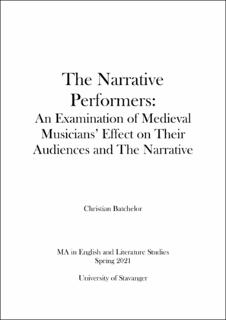| dc.description.abstract | In this thesis, the field of oral tradition developed by Milman Parry, Albert Lord and later expanded by John Miles Foley will inform our perspective of the medieval texts “Cædmon’s Hymn” by Bede and Sir Orfeo in order to understand the performative nature and its implications on the narrative. Specifically, attention will be given to the inclusion of musical accompaniment and interplay between narrative composition and performance as laid out in Linda Marie Zaerr’s exhaustive work Performance and the Middle English Romance. Similarly, Foley’s theory of metonymic reference detailed in his work Imminent Art: From Structure to Meaning in Traditional Oral Epic will aid in identifying metonyms resulting from the inclusion of instrumental accompaniment in the performance of “Cædmon’s Hymn” and Sir Orfeo. In addition to Foley’s metonymic reference theory, his ideas on the performance arena discussed in his work The Singer of Tales in Performance will better our understanding of the importance of each texts’ musical register and the arenas in which they would be performed. The purpose of this thesis will be to broaden our understanding of the connection between the instruments and musical properties of oral performance with the performer. Additionally, as we investigate the significance of the instruments and the poet, we pose the question whether our findings illuminate new narrative details regarding the inclusion of instruments in the two oral texts. Foley discusses the use of harmony and musicality as tools for “summoning” narrative meaning through artistic imperative (Tales in Performance 5-7). Additionally, as we will see, Zaerr discusses the meaning added to both performance and narrative due to the improvisational skills of the singer and instrumentalist (110; 118; 144). Working with these discussions, there may be correlations between the instruments used for symbolic and metaphorical purposes and the metonymic value garnered by the audience. Foley states that both the poet and the audience rely on their own pool of experiences based on the specific “context of tradition” suggested by the performance (Tales in Performance 7). Thus, our goals are two-fold: How does our understanding of the instrument expand our knowledge of the performance, and how does the inclusion of the instrument in the poem expand our knowledge of the narrative. | |
